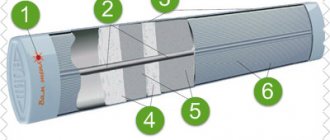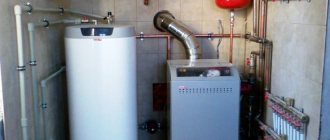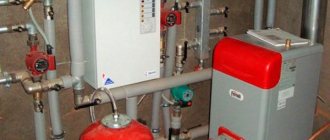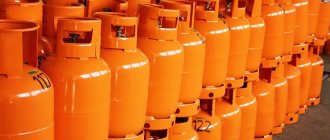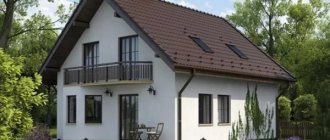Here you will learn:
- How does infrared heating work?
- Scope of application
- Advantages of infrared heating
- Cons of infrared heaters
- Heating system design
- Types of IR heaters
- Classification according to the method of arrangement of elements
- Impact on humans
- Monthly costs of infrared heating
- Equipment selection criteria
In nature, the infrared wave spectrum is emitted by the sun. Thanks to the heat of radiation, all life on the planet exists. In a household heating system, the role of the sun is played by infrared units.
The operating principle of artificial heating is no different from natural heating. Just like the sun's rays warming the earth's surface, IR equipment transfers heat to objects indoors. The operating pattern is significantly different from other types of heating. In such a cycle, it is not the heated air that gives up part of its temperature to the surrounding elements, but, on the contrary, objects heated by thermal radiation transfer heat to the air. IR film for floors and ceilings, heating devices and panels can be used as heaters.
How does infrared heating work?
In nature, infrared radiation is included in the spectral region of electromagnetic waves emitted by the main “luminary” of our system – the Sun. Thanks to the invisible wave spectrum emitted by it, all living things on our planet are capable of developing.
Scientists divide infrared radiation, which is referred to as “thermal”, into three components, distinguishing the near, middle and far spectrum.
The most effective for heating and the safest for living organisms are electromagnetic oscillations, immediately following the visible red side of the middle spectrum.
Almost 50% of the solar spectrum is occupied by infrared rays - the radiation closest to the human body
The wavelength range of radiation, called “rays of life,” ranges from 8 to 14 microns. In a number of sources, the “life-giving” interval is slightly increased: from 6 to 20 microns. However, even these discrepancies in the readings are not critical.
It is the long-wave spectrum, close in value to the radiation of the human body, that is involved in the development of equipment and the arrangement of a heating system with infrared heaters.
Heating plates used in infrared heating generate heat with an operating range of 5-15 microns
Infrared installations can be considered a kind of mini-sun. The only difference from the natural “luminary” is that they will warm up the space constantly, regardless of the weather conditions outside the room. Such installations operate in everyday life from a 220V network.
Infrared rays, passing through air barriers, heat the hard surfaces of objects in the room, and they subsequently redirect the heat into the space
The heating element, which is the main component of the device, distributes light waves. Thanks to the reflector, during operation of the equipment, the object at which the device is directed warms up.
The role of “receivers” and then “emitters” of heat can be performed by any objects in the room: ceramic and stone objects, wooden and glass surfaces, living organisms.
Objects receive heat or transfer it to a nearby space. During operation of the equipment, the surfaces of interior items in the radiation zone are 7-10 degrees warmer than the surrounding air.
Heating with infrared rays can be perfectly combined with other traditional heating methods, making it easy to create a “heat island” – a zone of increased comfort – in any room with minimal effort.
Both at the domestic level and on an industrial scale, this type of heating is convenient to use as auxiliary or emergency heating. Heat losses during its use on average do not exceed 10%.
The costs associated with installing infrared heating pay for themselves in 2–3 years. The systems consume no more than 10 - 15 W per square meter and do not require repairs or regular maintenance
IR heating film is placed under finishing on building structures and does not “eat up” usable space
Infrared heating systems are installed on ceilings. The film is covered with plasterboard ceilings, finishing panels, slatted systems, etc.
Using IR film, a floor heating system is constructed. Infrared heating works perfectly in tandem with floor ceramics, linoleum, laminate, carpet
IR systems are used in the arrangement of attics, thereby reducing the cost of organizing insulation of the space limited by roof slopes
The film version is excellent for heating terraces, loggias, winter gardens, and balconies. Objects heat up, not air, so it can be used in open areas
Infrared heating devices include IR devices, which can serve as both additional and main equipment for heating a country house
IR films and heaters increase the temperature from 5º to 20º C in 30 - 50 minutes from the start of operation. They heat objects and structures, which then transfer heat to the environment
Criteria for proper selection of equipment
The main thing you should focus on when choosing heating elements is their design and operational parameters. To calculate the optimal power, use the classic formula, taking as a basis that heating 10 meters of area requires an average of 1.2 kW.
There are also mobile units on sale that are convenient to use for temporary heating, placing them in the desired location of the room and, if necessary, taking them out onto the site. They operate on both electricity and gas.
Such a portable IR heater can effectively heat an area with a radius of 2.5 meters, filling the room with comfort and warmth.
If we compare floor- and ceiling-type models, the difference between them will be insignificant, since in any case the floor and lower part of the walls will warm up first, and warm air will still rise upward. For this reason, look only at how convenient it will be to place the equipment on the ceiling or floor.
Models with a built-in temperature sensor are convenient to use: when the temperature in the room drops below the set point, the equipment automatically turns on, and when the set value is reached, it turns off.
Preference should also be given to devices whose design allows you to adjust the tilt of the radiation direction.
When choosing a product, pay attention to the presence of a thermostat, with which it is convenient to set a certain mode and thereby save energy consumption
In general, when choosing heating elements, you need to be guided by the parameters of the product, the materials from which the house is built, the presence of another type of heating system, and, of course, your financial capabilities.
But don’t be tempted by products with unreasonably low prices. In an effort to reduce production costs, some manufacturers do this at the expense of quality, saving on contacts and using low-quality wires.
Scope of application
Despite the fact that some PLEN manufacturers position their products as an alternative to central heating, independent use of that system for heating a summer house, house, store, warehouse or other type of building in winter is not economically profitable. To do this, it is better to use a water boiler and a tubular floor heater, despite the fact that the installation of such equipment is much more complicated. As for industrial and production premises, gas emitters are more suitable for them.
Gas-radiant heating of the workshop is most efficient when installed on the ceiling
The ideal application area for IR films is an auxiliary heating system, which is used to heat a nursery, loggia, French balcony or floors of a private house.
This system can also be used to heat small auxiliary spaces, such as a garage, poultry or chicken coop, basement, etc. PLEN is often used as a soil heater in a polycarbonate greenhouse.
Taking into account the facts stated above, it can be stated that the efficiency of PLEN decreases with increasing heating area.
Adviсe
The decision to install a particular heating system in a private home should be made carefully, since few people decide to redo the entire property. If there are problems with the gas supply, then you can choose an alternative - PLEN heating.
Laying PLEN on the floor
It is easy to install it yourself, but do not forget about the choice of finish. And also correctly calculate the required power and location of the thermostat. During operation, you will appreciate all the benefits of “warm film” in your home.
One of the most pressing issues for owners of country houses, cottages, dachas, bathhouses, and other country-type buildings is the issue of heating. Today there are three main types: solid fuel, gas and electric heating. Let's try to figure out which one is better. Let's calculate three options for heating a small country house of 90 m 2.
Advantages of infrared heating
When compared with traditional heating methods using convectors and oil radiators, the infrared panels in question have a number of advantages:
- Fast heating. When the equipment is turned on, the temperature in the area of its operation rises after 1–2 minutes. This is due to the fact that the rays are not scattered in the air, but reach their direct destination with little loss.
- Quiet operation and environmental friendliness - the operation of the equipment does not produce any sounds or vibrations. During the heating process, no harmful substances are released that could harm residents. Also, film infrared heating dries the air to a lesser extent, since heating occurs not from the hot surfaces of the radiator, but from warm pieces of furniture, walls, and floors.
- Wide application - these systems can be used not only in the home, but also in industrial premises, garages, utility rooms, and on the street.
- Effective air heating. Conventional radiators heat air, which rises, cools and falls down. As a result, the temperature at the feet is always lower than at the ceiling, which is not entirely correct. Infrared heaters direct rays from top to bottom, as a result of which the floor and pieces of furniture below are heated - heat emanates from them, so the air temperature below will be approximately equal to the temperature above. Also, convection currents (air circulation) are noticeably weaker.
- Unlike conventional electric convectors, infrared systems do not burn oxygen and do not dry out the air.
We can talk for a long time about the advantages of these systems.
Operating principle
Infrared heaters differ from convective heaters in their operating principle - they do not heat the surrounding air mass, the radiation heats objects in the area of operation of the unit. And the already heated floor, walls and furniture release heat into the air. Since solid bodies shield the waves emitted by the heater, the floor under the table in their path will not warm up, but the heated table itself will release the resulting heat in all directions. Although comparing infrared heaters with the sun is more of a marketing ploy, their radiation spectrum characteristics are similar.
Cons of infrared heaters
Unfortunately, infrared heaters still always emit that menacing orange-red glow! And most importantly, zone heating is not suitable for everyone. Admittedly, such a heating system may be far from ideal. A limited heat zone is not suitable if you change locations frequently.
Radiant heat has the characteristics of linear propagation, so a group of people cannot use the same heater at the same time. There are quite powerful models that can heat the entire room, but their operation is more efficient if a person is located directly on the radiation line.
Infrared heating of a private home begins to warm immediately after switching on. The other side of the coin is that they stop generating heat immediately after switching off. Since the air in the room is not actually involved in heating, the room cools down in a matter of minutes. At the same time, the oil-filled radiator will continue to give off heat even when turned off - the heated oil will take time to cool completely.
Electricity consumption when operating infrared heating is undoubtedly less than oil heaters, so the system can be called economical. The energy efficiency of the equipment is more pronounced if the task is not to heat the entire house for an extended period.
Efficiency
There are a number of reasons that increase the effectiveness of infrared systems.
The first reason is the presence of radiant energy released by infrared heating. A person constantly loses heat. These are secretions, breathing, heat radiation. Most of the losses occur through heat radiation through the surface of our body; heat can be replenished in the opposite way.
Scientists conducted an interesting experiment when they created special conditions for the people being tested. When they were initially placed inside a room with well-heated air, but the walls were specially cooled, the people froze. When the air was cooled, but the walls were heated to high temperatures, the effect was the opposite - they felt warm and comfortable, some noted the appearance of perspiration.
The reason for such a reaction, the sensations of the subjects, lay in the radiant energy falling on a person, which was then converted by him into heat energy. Therefore, maintaining comfortable room conditions is possible at lower air temperatures than with conventional convection-type heating, but the comfort created is no less, therefore, energy is saved.
The second reason is the air flow exchange coefficient, an indicator of how much air is lost through loose joints and cracks, doors, and how much it is replenished with fresh, cool air. The absence of circulation created by convection currents made it possible to obtain a coefficient of 0.2-0.6, and in its presence it exceeded 4.5. This is the maximum value for rooms with frequently opened doors, for example, in a store.
In addition, building materials can be saturated with moisture. In cold weather, the presence of moisture increases the thermal conductivity of the walls, and if they are frozen, then even more. Infrared heating allows you to prevent this by starting to warm up the room from the walls. They are dried, moisture is removed from them, and air that gets in instead improves thermal insulation. As a result, energy consumption decreases.
The third reason is smaller temperature differences inside the room along the height. If infrared radiation allows you to reduce the temperature difference to a degree or two, for example, near the floor - 19°, under the ceiling - 20°, then with conventional heating this can be 19° and 23°, respectively.
Heating system design
As with any other electric heater, the main part of an infrared heater is the heating element: halogen, carbon, ceramic or tubular. The body can be metal, ceramic or a combination of metal and plastic.
Depending on the type, IR heaters are available with reflectors or heating panels. In the first version, the heating element is covered only by a protective grille, and the reflector (reflector) not only enhances infrared radiation, but also localizes the heating zone; in the second, the heating element is covered with a blank panel. Depending on the brand and price category, the heaters have mechanical or electronic controls (with a timer); the electronics can be controlled from the remote control. But even budget models are equipped with protection against overheating, moisture and tipping over (floor-standing).
To minimize energy costs, thermostats are connected to the heaters to regulate the operating mode.
The power of the devices starts from 300 W and varies over a wide range (there are units of 2 kW and more), but, as with convectors, our craftsmen advise covering the area with several devices of lower power. Marketers claim amazing savings and minimal electricity consumption, but no one has repealed physical laws. To generate a certain amount of heat, the device must spend a certain amount of energy, and in this case there is nothing unexpected - 1 kW per 10 m² of area, if everything is difficult with insulation in the house, then it’s worth throwing a little on top.
Another thing is that in a well-insulated room, where heat does not escape through the walls, floor and ceiling, the windows and doors are sealed, and ventilation is not due to drafts, the heaters will reach the set mode faster, and less electricity will be required to maintain it. And since the principle of operation is such that surfaces are heated not by air, but by radiation, as a result, electricity costs may be slightly lower than when heating with convectors or other electric heaters. But again, everything is purely individual.
Installation features
The installation procedure for infrared heating panels is not complicated: just follow the instructions in the instructions. It can be found on the website of the manufacturer of the purchased equipment. After completing the installation work, you only need to plug in the device into the electrical network.
IR heaters are mounted on walls and ceilings. When choosing a ceiling device, you should consider the following recommendations:
- It is important to prepare suitable fasteners: they must be strong in order to reliably hold the weight of the device being installed.
- The heater is fixed using the fasteners that come with it. Often these are steel chains and rigid brackets.
- During the installation process, it is necessary to prevent contact of the heating surface with flammable substances and materials.
- Using a special tape, it is important to insulate the electrical wiring contacts.
Types of IR heaters
Conventionally, they can be divided into the following:
- Thermal plates.
- Quartz pipes.
- Open spiral.
More details about all three:
- Plates are in greatest demand. These are flexible polymer elements with conductors installed inside. Such a plate heats up to 100⁰, and does not burn oxygen or dust. It is installed as a ceiling heater or floor covering. Heating a home with infrared heaters of this type is very popular due to its size. The parameters of the plastic panel allow you to cover a large area, so heating even a king-sized house will not be a problem.
- Pipes, vacuum inside, heat up more. The spiral inside becomes red hot. The efficiency of such heaters is high, but at the same time they are not popular, since due to the high temperature, dust deposited on the heater itself can burn. This is unsafe and also produces a strong burning smell. Such conditions can hardly be called ideal.
- Heaters with open coils were installed in all houses at one time. They were warm, but the oxygen was burned with terrible force. Such heaters cannot be left overnight or, in general, without control - the fire hazard is too high. Now such models are no longer produced.
Many models are wall-mounted or wall-mounted units. They fit perfectly into your home environment.
How to choose yours? First, you should determine the advantages and disadvantages of the entire system - perhaps the choice will fall on alternative sources.
Briefly about the main thing
Heated windows are an innovative translucent design that has completely changed the concept of conventional double-glazed windows. The main function of the system was additional heating of the room, eliminating the need to use batteries and radiators.
If we compare heated windows and electric heating devices, the latter is useful only in the case of a built-in floor heating system. Heating double-glazed windows in combination with the heat supply on the floor create a thermal curtain, which will cause condensation to appear.
In other cases, thanks to getting rid of ice crust on windows, frost, as well as maintaining a comfortable temperature inside the house, the innovative design wins over conventional batteries. Plus, double-glazed windows can be used as a decorative element, because there are various coating options - from matte to darkened.
To find out the exact price for heated windows, as well as to order an innovative design, contact. Occupying a leading position in the domestic market, the manufacturer maintains high quality products, providing support at all stages in cooperation with the consumer.
Ratings 0
Classification according to the method of arrangement of elements
Infrared heating devices are presented on the market in a wide range. According to the method of arrangement of heating elements, they can be divided into three groups: floor, wall and ceiling.
Floor heaters
Floor coverings are modular materials, inside of which flat heating elements are laid. The coating is produced in the form of rolls. For installation, it is cut into pieces of the required sizes.
Strips of rolled material are placed on the floor so that the emitters do not end up under heavy furniture; this will prevent a decrease in heat transfer and drying out of the wooden elements of the set
The material is laid directly on the prepared base floor. During the installation process, avoid placing the panels overlapping and try to maintain a distance of 10-15 cm from the walls.
The following can be laid on top of floor infrared panels:
- carpet;
- parquet board;
- linoleum;
- laminate;
- ceramic tiles.
The most successful combination is obtained when using ceramic tiles as a floor covering. Laminate is a little inferior in this regard. And the greatest shielding of IR radiation is created by carpet and linoleum.
Wall and ceiling units
Compared to underfloor heating systems, the choice of ceiling and wall-mounted units is wider. In addition to traditional panels, there are also designer built-in models of ceiling radiators. They can be installed in suspended ceilings. They are available for sale in different sizes and colors.
The plates are placed in such a way that the rays emanating from them are directed to the furniture, and the latter, having absorbed heat, begins to act as a source of thermal energy
Ceiling models of infrared emitters are located at a height of 3 meters and above. With this arrangement, the thermal ceiling is directed downward and diverges slightly to the sides. Rushing down, the rays first warm up the floor covering. Due to this, the temperature at the level of the feet is always a couple of degrees higher than in the head area.
To prevent heat from leaking into the street, the panels are not placed opposite doors and window openings.
Wall-mounted infrared emitters are placed so that they are above or below the level of a person’s head
Among wall emitters, it is worth highlighting baseboard systems. They are narrow, long structures. The systems are installed around the perimeter of the room, placing them instead of conventional plastic or wooden baseboards.
When choosing a location for placing panels, you should avoid recreation areas where there is a high probability of direct impact on household members. For example: at the level of a sofa or bed. Otherwise, the rays directed at right angles will overheat and dry out the skin, causing discomfort among residents and guests of the house.
The coverage area of directional emitters is one of the main characteristics and is usually indicated in the product data sheet.
IR wall heaters are rarely used. The circulation of warm and cold air occurs from bottom to top, so it is wiser to prefer ceiling or floor options
Varieties
It is most convenient to classify infrared heating devices according to their installation location.
Ceiling
Infrared ceiling heating is the most common, since the ceiling at a height of up to 3 m is the optimal place to install an IR source.
Most ceiling models are of the lamp type.
Their emitters are made in the form of a cylinder or plate, and the device itself has an elongated shape and resembles a fluorescent lamp.
You can fix the “heating pad” on brackets, but the most popular type of fastening is a suspension in the form of a chain, the length of which can be independently adjusted.
In addition to a lamp heater, you can place a film IR heater on the ceiling. This truly revolutionary invention consists of two layers of polymer film, between which there are tracks of carbon paste. It plays the role of an IR emitter. The heater itself has the form of a thin sheet, which is laid on the ceiling and screwed with dowels or self-tapping screws.
Wall mounted
Devices in this series can not only heat a room, but also aesthetically enliven its interior.
They are made using film technology (infrared film for heating), with a colorful pattern applied to their outer layer.
Such picture heaters have become very popular recently.
Floor-standing
Special models of IR film, equipped with a self-adhesive base, are designed for laying on the floor. After installation, the finishing floor covering is laid on top of the heater.
Infrared heated floor
Those wishing to install a wall-mounted picture heater should take into account that the surface of the device heats up quite strongly. If there are small children or animals in the house, the device should be installed so that they cannot touch it.
Impact on humans
Like any other radiation, infrared waves can be harmful to health. The degree of influence depends on the wavelength. Short-wave “luminous” heaters with a wavelength of up to 3 microns provide quick heating of open areas of the floor and surfaces of objects, but can lead to overheating of the upper layers of the skin, drying it out and even burns. Such emitters are used in solariums.
The most comfortable for humans are heaters with an operating wavelength of more than 7 microns. Such waves penetrate deeper into the body, but do not have a burning effect and are not harmful to health.
Bimetallic devices for panoramic windows
This type of radiator belongs to heat supply equipment, the high cost of which best corresponds to the quality.
Bimetallic radiators differ:
- High working pressure.
- Compatible with other metals. In them, aluminum is used only for the manufacture of the shell, which increases the aesthetics of appearance and heat transfer. As for the internal casing, equipped with outlets for connection to the system, it is made of stainless steel or black steel.
The height of bimetallic radiators for panoramic windows ranges from 24.5 to 45 centimeters.
Monthly costs of infrared heating
When using any heating system, you have to pay for its operation every month, whether it is gas, electricity, wood or liquid fuel.
A warm ceiling consumes from 10 to 20 W per hour per 1 m² of heated room area. For example, consider a house with an area of 100 m².
100 m² * 15 W (take the average value) * 24 hours a day * 30 days/1000 (1 kW = 1000 W) = 1080 kW per month.
Let's convert the received calculations into a monetary equivalent, for the cost of kW we take electricity tariffs for the population living in Tyumen and urban settlements of the Tyumen region in houses equipped in the prescribed manner with electric stoves and (or) electric heating devices, a single-rate tariff for electricity is 1 .81 rub.
1080*1.81=1954 rub.
Heating costs for such a house are only about 2,000 rubles. per month! Agree, this is not at all a lot for heating such a house.
Why do you need a warm window sill?
In the building design, openings with wooden or metal-plastic windows remain the main route for cold penetration into the room. The small thickness of the double-glazed window, only 7-12 cm, is not able to compete in heat retention with a foam-insulated wall, and even more so with heat-insulating blocks. And the brickwork or concrete slab itself into which the frames are inserted does not guarantee reliable thermal insulation, especially when installation is done only with polyurethane foam without additional insulation.
And although central heating radiators are usually located in this place, it is unlikely that it will be possible to ensure proper heating of the opening. Condensation and dampness will still appear on the slopes and glass.
The solution to this problem is quite simple - to provide heating of the opening with a device that will specifically heat only this opening, blocking the penetration of cold into the room. Constant temperature and directed heat flow will not allow dampness and condensation to accumulate on glass and slopes, and will rid the apartment of dampness, mold and mildew.
Installation
Each conscientious manufacturer completes its product with detailed instructions, which indicate:
- minimum permissible diameter and number of fasteners;
- brand of wire that should be used to connect the device to the network (for example, PVA 3x1.5);
- minimum installation height (depending on power).
All instructions given must be followed with the utmost precision.
Before installing infrared heating, especially if it will include several devices, you should make sure that the wiring in the house can withstand such a load.
Often, IR heaters are connected through a thermostat, which turns off the device when the set room temperature is reached. This element should be installed in a place so that it is not exposed to sunlight or radiation from the heater.
When installing a film heater on the ceiling, the fasteners should be screwed into special tracks that do not contain carbon “filling”.
The effectiveness of IR floor films will depend on the type of finishing coating. Ceramic tiles provide the best heat transfer; laminate tiles are slightly inferior to them. Linoleum and carpet have the lowest thermal conductivity. You should also avoid carpeted floors.
Connection diagram for infrared heated floor
The floor film heater should be installed in an area free of furniture.
It is necessary to take into account that inexpensive models of film heaters do not contain a foil layer that acts as a reflector. In this case, the foil must be purchased separately and placed under the IR film, otherwise a significant portion of the heat will go into the building structures.
If you are afraid of drilling a wire laid in the wall, use a special detector. This device scans the thickness of any material and if it detects metal elements or live wiring, it issues a warning signal.
Heating the entire room
Efficient heating of an entire room is possible using low intensity infrared heating elements, but the heating system must be designed and installed well, and used accordingly. The most basic mistake during installation is that the user installs one large heater, which, according to its parameters, will be neither effective nor economical. One large heater creates an intense heating zone and has the unintended consequence of cold air flowing from other parts of the building, thereby causing the objects under the infrared heater to become intensely warm, but the person can feel the cold air from below. A more efficient design practice is to design a balanced system that can use two or more heaters located throughout the area to provide comfortable heat within the room.
